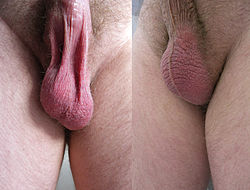
Back Skrotum Afrikaans Escroto AN صفن Arabic ܟܝܣܐ ܕܐܫܟܐ ARC كيس الخصيه ARZ Mackimotai ATJ Eskroto BCL Машонка Byelorussian Машонка BE-X-OLD Kantong biji pelèr BEW
In most terrestrial mammals, the scrotum (pl.: scrotums or scrota; possibly from Latin scortum, meaning "hide" or "skin")[1][2] or scrotal sac is a part of the external male genitalia located at the base of the penis. It consists of a sac of skin containing the external spermatic fascia, testicles, epididymides, and vasa deferentia. The scrotum will usually tighten when exposed to cold temperatures.
The scrotum is homologous to the labia majora in females.
- ^ van Driel, Mels (2010). Manhood: The Rise and Fall of the Penis. Reaktion Books. p. 11. ISBN 978-1-86189-708-4. Retrieved October 14, 2023.
- ^ Spiegl, Fritz (1996). Fritz Spiegl's Sick Notes: An Alphabetical Browsing-Book of Derivatives, Abbreviations, Mnemonics and Slang for Amusement and Edification of Medics, Nurses, Patients and Hypochondriacs. Taylor & Francis. p. 142. ISBN 978-1-85070-627-4. Retrieved October 14, 2023.
